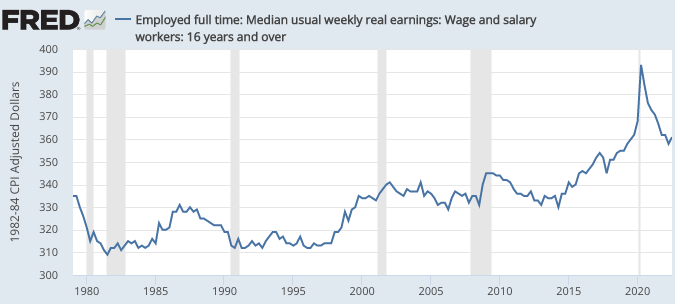"Yes.
Let’s start with some data:
A few comments:
1.This deflates median wages by the CPI. Most economists believe the PCE is more accurate, and it would show much more rapid real wage gains.
2. This excludes fringe benefits, which have improved much faster than money wages.
3. On average, families are smaller, hence there are fewer children to raise.
4. If I had used average wages, the increase would have been even greater, as top end incomes have risen faster than median wages.
To summarize, this is a conservative estimate of the gains in real wages. So why the perception that it now takes two incomes for the lifestyle that one income once supported? I see many factors:
1. In a few places such as Silicon Valley that claim is clearly true, at least for workers with median incomes. Influential pundits often live in places where house prices have risen much faster than average.
2. We now have higher expectations. Suppose you are a median worker that wished to reproduce a 1960s lifestyle. How do you do this? You’d move into a 1200 square foot ranch house with one bath in a working class immigrant neighborhood. To get a car as unreliable as a 1960s car, you must buy a cheap 15-year old car. To get a TV as bad as a 1960s TV, you find one that someone left out at the curb. You give up your cell phone. No vacations by jet, it’s a drive down to Disneyland. You get the idea.
3. After the 1950s, a steadily increasing number of women began working. As two incomes became the norm, the lifestyle that two incomes could support because the norm. Now families wanted a 2500 square foot house with a big kitchen and three baths. They expected a reliable car, a big flat panel TV and an iPhone. They flew to Disney World instead of driving to Disneyland. Humans are social animals, so the perception of “necessities” depends mostly on what sort of lifestyle you see among your friends and family. Keeping up with the Jones.
Pundits seem surprised that people now believe it takes two incomes to support a family, whereas one income would have been adequate in the 1960s. In retrospect, however, this was inevitable once America’s married women decided to enter the labor force in large numbers. It would have occurred even if real wages had increased 10 times faster.
If you don’t believe me, you might want to study more extreme cases, such as China and South Korea, where real wages did increase at least 10 times faster. If you speak with people from those countries, you’ll often hear claims that the birth rate has fallen to very low levels because it is too costly to raise children today. In one sense, that’s obviously nonsense. Back in the early 1960s, South Korea was as poor as sub-Saharan Africa and (like Niger today) Korean women had roughly 6 children on average. Today, South Koreans are vastly richer, even adjusting for the rising cost of living, and they have 0.8 children.
In places such as China and South Korea there has been a radical change in expectations, in all sorts of dimensions. Not just the number of goods that are viewed as necessities, but also the expectations for childrearing. Far more effort is now devoted toward getting kids into the best universities.
Thus although Chinese and Korean parents are obviously not too poor to have larger families, there may be a sense in which economic factors are influencing family size. But it has more to do with a change in acceptable lifestyles, rather than in any lack of growth in real wages."
https://fred.stlouisfed.org/series/COMPRNFB

No comments:
Post a Comment
Note: Only a member of this blog may post a comment.